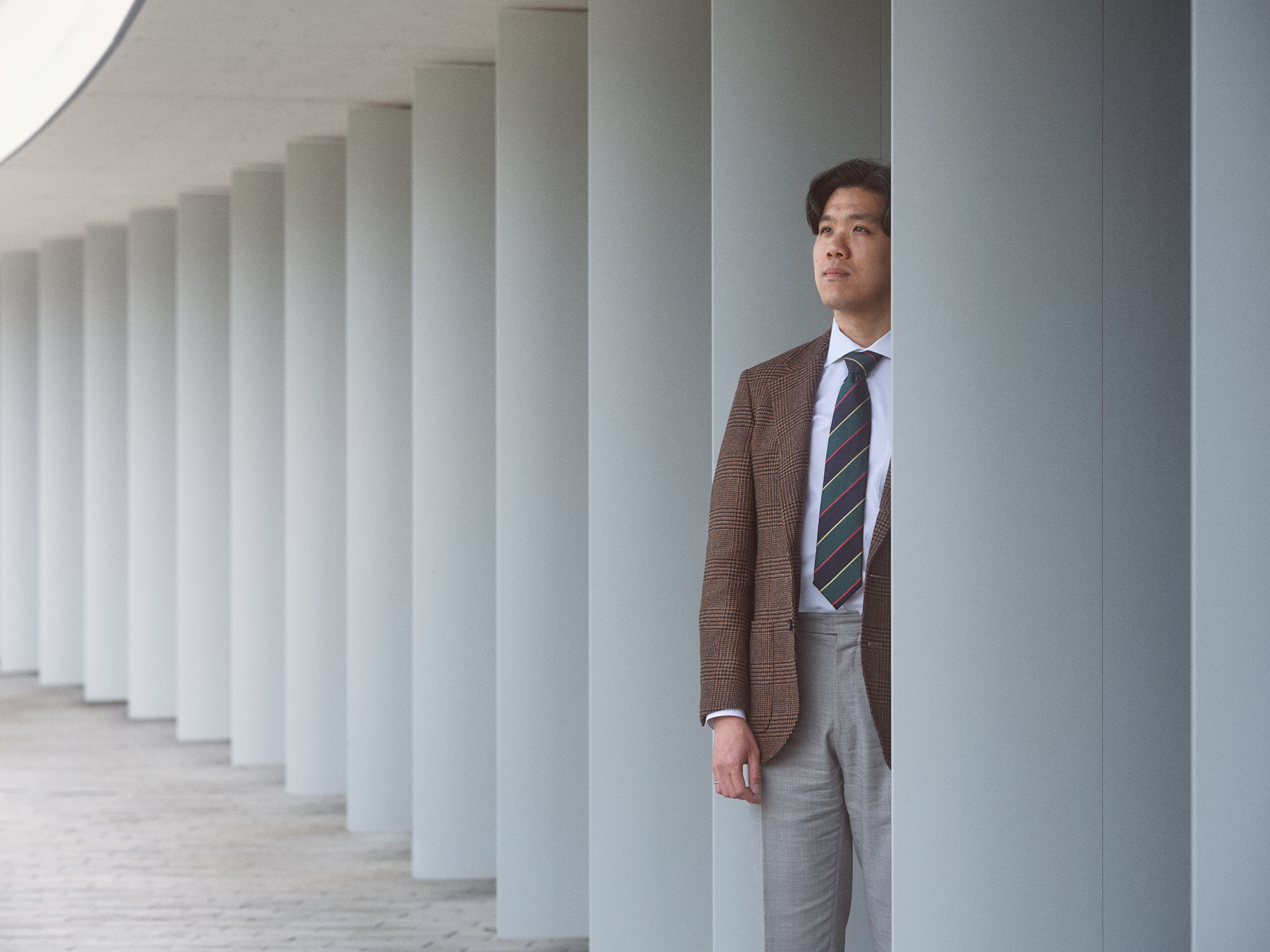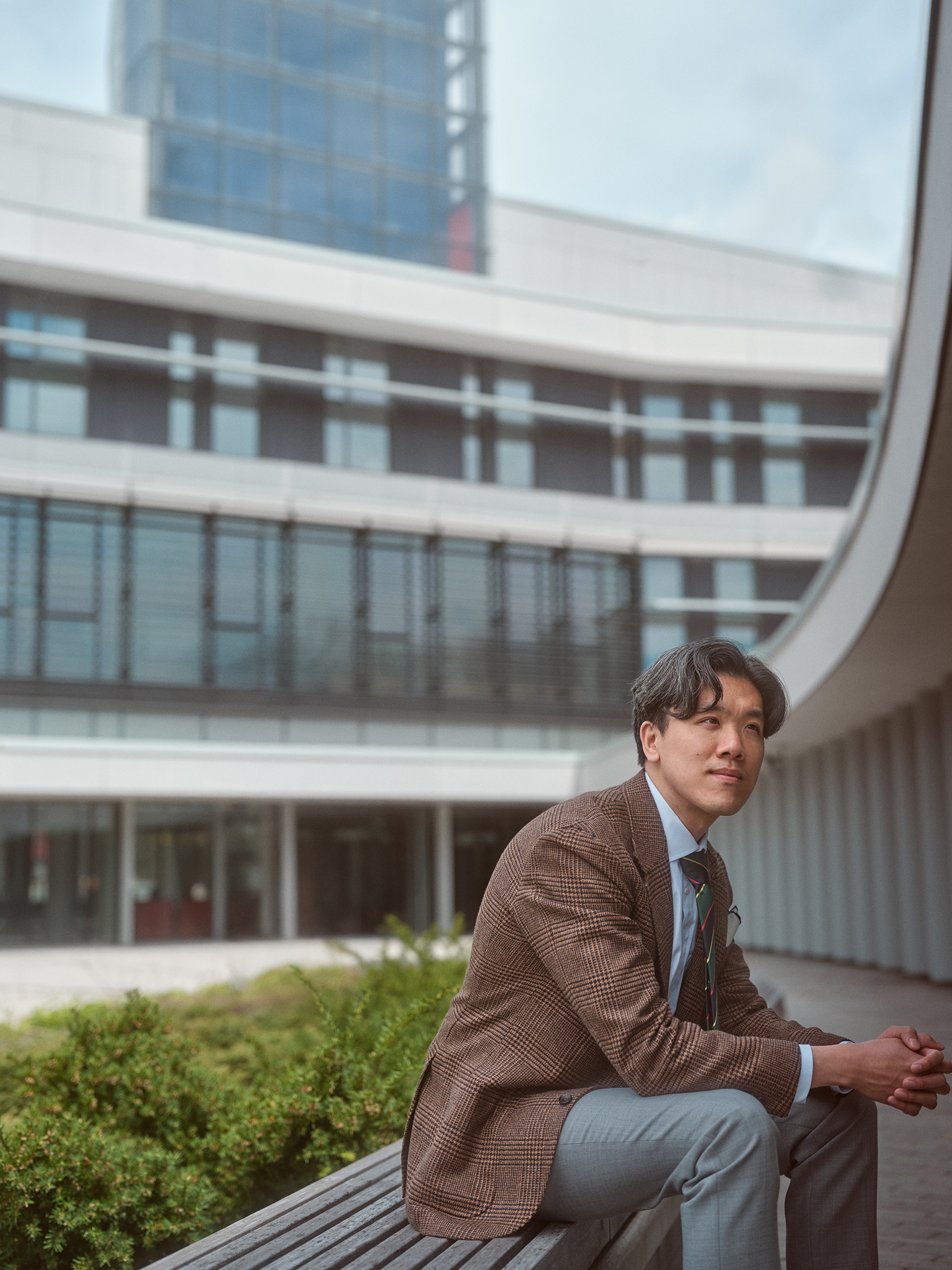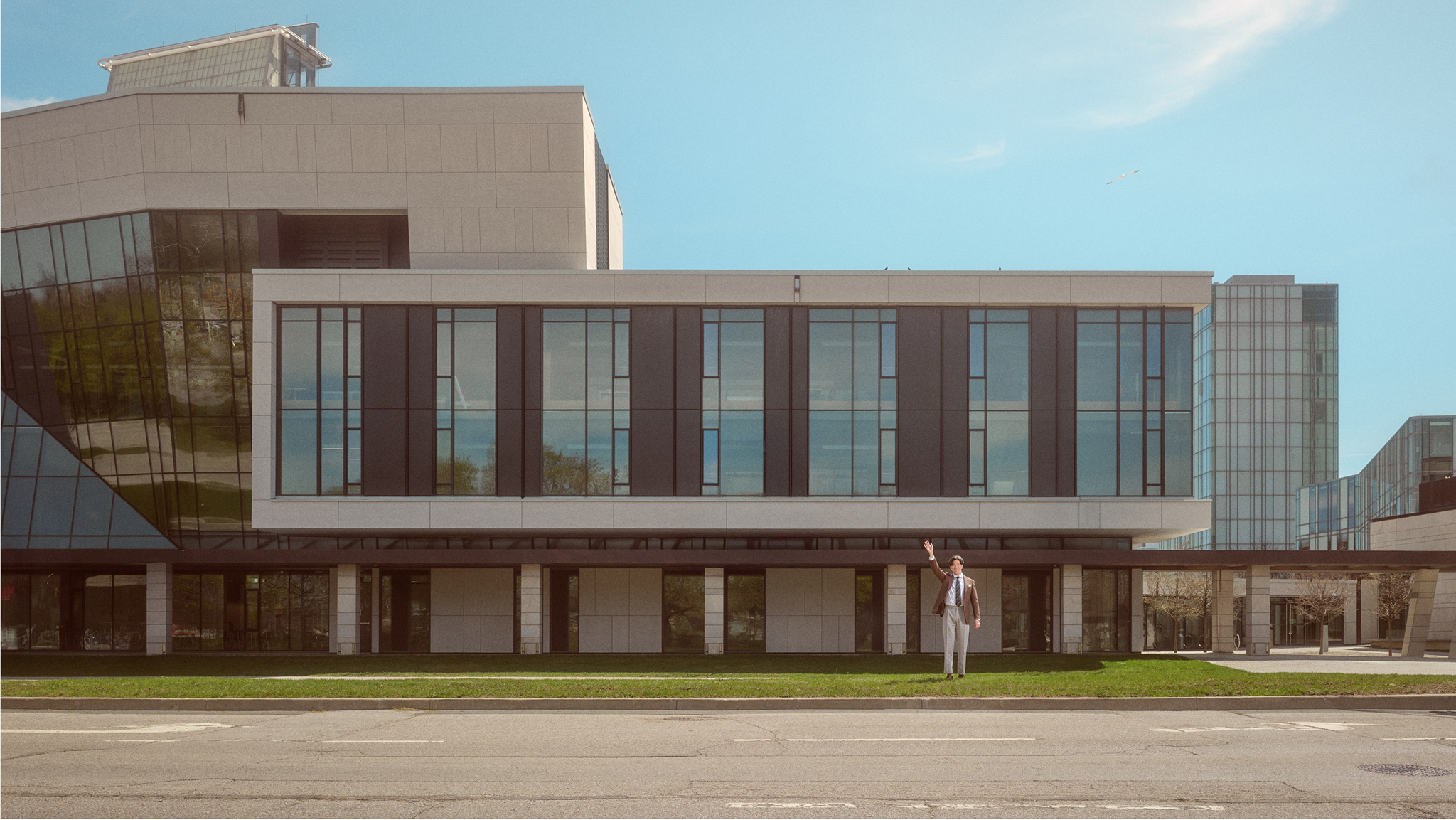Pushing the Envelope
by Deirdre Kelly
photography by Chris Robinson
Kevin Zhang can’t hide his enthusiasm as he strides through the Rob and Cheryl McEwen Graduate Study & Research Building at York University. He stops in the atrium, points upward and grins. “See that big glass tower sticking out of the middle of the building? That’s the solar chimney,” he says, his voice rising with excitement. “It’s one of the coolest features here.”
A building scientist and professor at York’s Lassonde School of Engineering, Zhang then launches into a rapid-fire explanation. “Hot air rises because it’s less dense. If you have a tall cylinder – a chimney – inside a building, and you open a hole at the top and a door at the bottom, the rising hot air creates suction. It pulls cooler air from the lower part of the building up and out. It’s like free air conditioning, just by letting physics do the work.”
He gestures again, tracing the path of invisible air currents. “Humans have known about this for centuries. Old clay buildings in the Middle East used the same principle. The solar chimney here isn’t as tall as the one at Manitoba Hydro Place in Winnipeg, which runs almost the full height of a skyscraper, but it works on the same idea – using natural convection to keep the building cool and comfortable, with hardly any energy.”

The McEwen building, which opened in 2019 on York’s Keele Campus, is a showcase for these ideas. Designed by Baird Sampson Neuert Architects, the $50-million, 67,000-square-foot facility stands among the most environmentally sustainable academic buildings in North America, with features such as the aforementioned 27-metre solar chimney, green roofs, rainwater recapture and more than 200 operable windows – all part of the building’s “envelope,” the protective skin that separates inside from out. The building is naturally ventilated about 40 per cent of the time it’s occupied, and its advanced, climate-adapted design has earned national recognition, including a Canadian Green Building Award.
All part of the building’s ‘envelope,’ the protective skin that separates inside from out
James McKellar, an architect by training and professor emeritus at York’s Schulich School of Business, oversaw the project’s development. “The building achieves a 50-per-cent reduction in energy use compared to similar modern structures,” McKellar says. “People comment about the air. In a normal building, the air is constantly being recirculated. In our building, the air is very fresh and people notice.” He adds that the most significant advancements centre on the occupants: “The goal is to use technology to create spaces that improve people’s experiences.”
For Zhang, these engineering solutions are more than clever tricks – they’re essential tools in the fight against climate change. He points out that buildings account for about 30 per cent of Canada’s carbon emissions, mostly from construction and operation. “This is still a big chunk we can reduce,” he says.

Zhang’s experience isn’t limited to academia. Before joining York, he worked as a consultant on sustainable building projects across Canada, helping design building envelopes for both new and retrofitted low-carbon buildings. “Many of [those] projects were to use local labour. We had forgotten that, coming from Toronto, construction folks often had experience with newer methods and materials for sustainable buildings. Out in smaller communities, there wasn’t as much experience.”
To bridge that gap, Zhang’s team brought in manufacturers to train local crews on high-performance products. “Having large projects like this helps to spread the knowledge – a rising tide raises all ships.” Retrofitting old buildings, he says, is one of the most effective ways to cut carbon. “The literature estimates that retrofitting existing buildings results in up to 75 per cent less carbon than building a new building. We have lots of existing old buildings! Let’s fix ’em up!”
But even with technical solutions in hand, the path to greener buildings isn’t straightforward. “We’re at this strange place where all of these signed agreements – the Kyoto Protocol, the Paris Agreement – that have big global fanfare end up fizzling out a bit because countries cannot commit to the targets due to financial and political challenges,” Zhang observes.
“It’s come down to smaller governments, especially at the municipal level, to really spearhead policies to drive change.”
Toronto is one of the cities leading the way, with its Toronto Green Standard requiring all new developments to meet strict guidelines on energy use and carbon emissions, aiming for net zero by 2040. “They are quite stringent and have a set path to become more stringent every few years.”
Studies show that sustainable buildings may cost just over six per cent more to develop, but can rent for up to 36 per cent more
Other cities, among them Boston and New York, are setting similar standards. But cost and public awareness remain major barriers. “Generally, with higher-performance buildings, there are more resources required for materials and time spent on designing and quality controlling the construction. This can really add up on a large project,” Zhang says. Still, he’s encouraged by the market’s response.
“Developers are able to pass on some of the cost to their tenants as the market is very pro-sustainability. Studies show that sustainable buildings may cost just over six per cent more to develop, but can rent for up to 36 per cent more,” he says. “That premium shows there’s real demand for greener buildings.”

But while commercial construction is adapting, the situation is much tougher for individual homeowners. The challenge, he says, is even greater for those who often lack access to capital and technical guidance for sustainable upgrades. “This is a huge part of the building stock that could benefit from sustainable upgrades. We had some programs to help with this, but they really only chip away at the cost. Plus, not every homeowner has access to an engineer or sustainability person to guide them through the process.”
It’s a dilemma Zhang often discusses with his students at Lassonde, reminding them that the impact of today’s choices will be felt far into the future. “What we’re doing today, no matter how good or bad, won’t really affect us that much. It won’t affect our children or grandchildren … but their children and grandchildren will feel it. Humans in the end are a bunch of mammals and we respond to consequences, so when there are none in our lifetime, how can we convince people to do better?”
Back at the McEwen building, where sunlight pours through the atrium’s glass, Zhang’s excitement is contagious. For him, the future of building science is as much about sharing knowledge and changing mindsets as it is about bricks and mortar. “A well-designed building envelope enhances resilience to heavier rainfall and extreme fluctuations in heating and cooling,” he says. “It’s about making sure our buildings are ready for what’s next – and that we are, too.” ■
— With files from Tina Knezevic